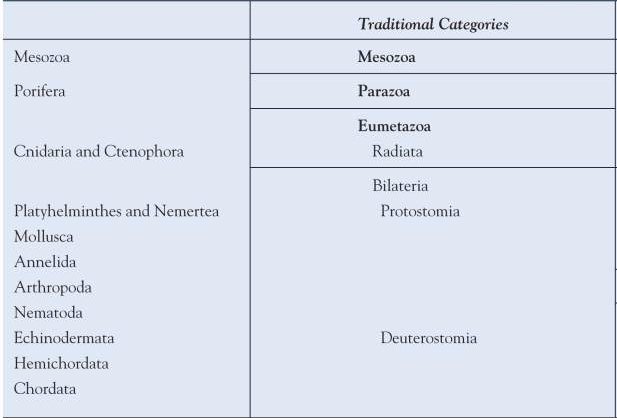Traditionally, the Animalia have been considered monophyletic (having a single ancestry) because of the impressive similarities in animal cellular organization. About 0.6 billion years ago, at the beginning of the Cambrian period, an evolutionary explosion occurred that resulted in the origin of all modern phyla (along with other animals that are now extinct). This rapid origin and diversification of animals is called "the Cambrian explosion" (see Animal Origins for more details about the Cambrian explosion) because it occurred over a relatively brief one hundred million-year period. This rapid appearance of all animal phyla leads some scientists to believe that animals may be polyphyletic, because such a rapid divergence of many kinds of animals from a single ancestor seems unlikely. This idea remains a minority view. This course takes the traditional approach and–with the possible exception of the sponges (phylum Porifera)–assumes a monophyletic origin of animals. The following brief description of taxonomy will help you visualize possible relationships among animals.

Taxonomic levels between kindgom and phylum are used to represent hypotheses of relatedness between animal phyla. Many zoologists recognize three major groups within the animal kindgom. These groups are often called branches and include the Mesozoa (phylum Mesozoa, the mesozoans), Parazoa (phylum Porifera, the sponges), and Metazoa, also called Eumetazoa (all other phyla). The Metazoa are further divided into two groups based on body symmetry and embryological characteristics (see figure above). In this system, the bilaterally symmetrical animals are divided into two large groups based on similarities and differences in the early development of the animals. The study of comparative embryology is based on the observation that embryological events may be similar because of shared ancestry. As with other comparative studies, however, embryologists must sort homologous developmental sequences from analogous developmental sequences.
Protostomes traditionally include animals in the phyla Platyhelminthes, Nematoda, Mollusca, Annelida, and Arthropoda. (see Zoology Terminology, Number 6. Protostome/Deutrostome, for the developmental characteristics that unite these phyla). One characteristic is the pattern of early cleavages of the zygote. In spiral cleavage, the mitotic spindle is oriented obliquely to the axis of the zygote. This orientation produces an eight-celled embryo in which the upper tier of cells is twisted out to line with the lower cells. A second characteristic common to many protostomes is that early cleavage is determinate, meaning that the fate of the cells is established very early in development. If cells of the two- or four-celled embryo are separated, none develops into a complete organism. Other characteristics of protostome development include the manner in which the embryonic gut tract and the coelom form. Many protostomes have a top-shaped larva, called a trochophora larva.
The other group, the deuterostomes, includes animals in the phyla Echinodermata, Hemichordata, and Chordata (see Zoology Terminology). The pattern of cleavage in this group is radial. Radial cleavage occurs when the mitotic spindle is oriented perpendicular to the axis of the zygote and results in embryonic cells directly over one another. Cleavage is indeterminate, meaning that the fate of the cells is determined late in development, and if embryonic cells are separated, they can develop into entire individuals. The manner of gut tract and coelom formation differs from that of protostomes. Some protosomes possess a kidney-bean-shaped larva called a dipleurula. There is, however, no single kind of deuterostome larval stage.
Even though these higher taxomonic grouings are traditional, some phyla (e.g., Platyhelminthes and Nematoda) do not fit well into either deuterostome or protostome groups. Cladistic analyses and molecular approaches to taxonomy are resulting in alternative groupings and are gaining widespread acceptance. This course will rely on the traditional interpretations of higher taxomony until a consensus opinion is established.